#china genghis khan
Explore tagged Tumblr posts
Text




Zhangye 张掖 is a prefecture-level city in Gansu province, China. It borders Inner Mongolia on the north and Qinghai on the south.
Zhangye lies on the frontier of China proper, historically protecting it from the nomads of the north and permitting its armies access to the Tarim Basin. During the Han dynasty, Han armies were often engaged against nomadic people (e.g. the Xiongnu) in this area. It was also an important outpost on the Silk Road. Before being over-run by the Mongols, it was dominated by the Western Xia dynasty, and before that it was a vassal state for the Uyghurs.


The Yuan Dynasty’s founder (Genghis Khan’s grandson) Kublai Khan is said to have been born in Zhangye. Marco Polo's journal states that he spent a year in the region during his journey to China.
#china#🇨🇳#gansu#gansu province#zhangye#chinese#people’s republic of china#chinese culture#chinese heritage#chinese history#sino#yuan dynasty#han Dynasty#western xia#nature#Western xia dynasty#uyghurs#Uyghur history#dunhuang#lanzhou#marco polo#kublai khan#genghis khan#Mongol Empire#chinese architecture#mountains#desert#landscape#chinese landscape#Chinese nature
194 notes
·
View notes
Text
turns out searching for a topic on libby produces books about that topic but watch out because you might stumble into a 13-book harlequin romance series set in the tang dynasty
#it doesn't look great but honestly the summary of one did give me a laugh. sure#at least it's that that rowland person writing their 18th detectibe story set in 15th century japan. I read one in hs#and it was weirdly homophobic. like noooo stop making your gay guy a pathetic wannabe idiot loser to your badass het mc!!#also idc that his relationship with his wife is in tatters. I fucking hate middle aged cishet man whining no matter the setting#anyway a bunch of romance manga showed up so I gave up on japan#got some cool books on china tho#and some on linguistics and one on genghis khan!#cor reads
4 notes
·
View notes
Text
"Living Dangerously"

So. Genghis Khan is out. Which may create the interesting question: why was Genghis Khan in in the first place? The answer was because Archie was chasing Laugh In and they thought this was what Laugh In would do: throw in a random picture of Genghis Khan, a mass of visual clutter. I suppose he is edited out not out any real cultural sensitivity reasons, but just to allow the gag to proceed unhindered to its non laughing conclusion.
#Archie Comics#Moose Mason#Jughead#Genghis Khan#1969#Gus Lemoine(?)#“700 years ago totally ravaged China. And we are told two hours ago totally ravaged Oshman's Sporting Goods”
2 notes
·
View notes
Photo
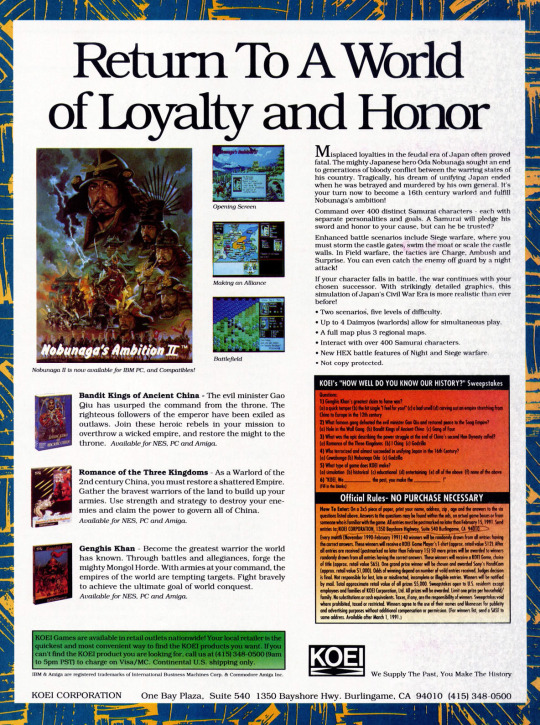
USA 1990
#USA1990#KOEI#STRATEGY#IBM#MSX#PC 88#PC 98#FM TOWNS#X68000#FM 7#SHARP X1#SEGA SATURN#NES#PS1#AMIGA#SNES#BANDIT KINGS OF ANCIENT CHINA#GENGHIS KHAN#ROMANCE OF THE THREE KINGDOMS#NOBUNAGA'S AMBITION II
23 notes
·
View notes
Text
doing a project with my small human in which he has to say a speech about any leader of his choice and he decided to do genghis khan who he then uwu-ifies by watching multiple youtube videos and going "oh he's not so bad in this one didi" SIR! Genghis Khan was many things but most prominently a feared overpowered conqueror STOP trying to make him cute and gentle oh it starts so young how can i bear it how can i possibly bear it
#genghis khan is just his little blorbo apparently.#the great wall of china was built for this man and you're out here telling me 'oh hes not SOOOO bad'#CHILDREN!#ciara’s convos
3 notes
·
View notes
Video
youtube
Genghis Khan BBC Part 4 5
Genghis Khan invading northern China The Siege of Beijing
0 notes
Text
The Rise and Fall of Genghis Khan and the Mongol Empire
The rise and fall of Genghis Khan and the Mongol Empire - A complete guide into the Mongol Empire
The Mongol Empire, one of the largest contiguous land empires in history, was established by Genghis Khan in the 13th century. Genghis Khan, born as Temüjin, rose to power through a combination of military prowess, strategic alliances, and innovative tactics. His leadership and the subsequent expansion of the Mongol Empire left a lasting impact on the world. Early Life and Rise to Power Genghis…

View On WordPress
#A Tad Nerdy#atadnerdy#china#empire#facts#genghis#genghis khan#history#mongol#mongolia#mongols#Travel
1 note
·
View note
Text
1206 - 1227 - In 1206, Genghis Khan was accepted as the leader of the Eastern Steppe tribes and all societies in the known world started becoming targets for the Mongols. Genghis Khan was very successful, but why was this?
#genghis khan#mongolia#kurultai#mongols#china#chinahistory#iran#khwarazm#uzbekistan#history#historyoftheworld#worldhistory#medievalhistory
0 notes
Text
3 Questions: Wiebke Denecke on a landmark project for Chinese literature
New Post has been published on https://thedigitalinsider.com/3-questions-wiebke-denecke-on-a-landmark-project-for-chinese-literature/
3 Questions: Wiebke Denecke on a landmark project for Chinese literature
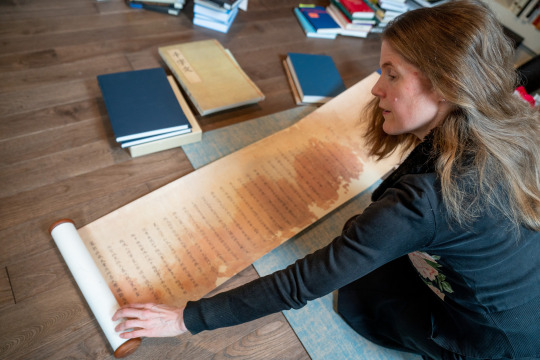

Nuns writing fine poetry. Centuries-old joke books. An epic travelogue ending with a visit to Genghis Khan. These are just a few things readers can experience through the new Hsu-Tang Library of Classical Chinese Literature, published by Oxford University Press.
The series is modeled on the Loeb Classical Library, which debuted in 1912 and features about 500 titles of Greek and Roman literature, in their distinctive red and green covers. The Hsu-Tang Library of Classical Chinese Literature series is starting with five titles, under the supervision of founding editor-in-chief Wiebke Denecke, the S. C. Fang Professor of Chinese Language and Culture in MIT’s literature section. The aim is to bring these classic texts, from the first millennium BCE through the early 20th century, to the world, in engaging bilingual editions. There will be four more new titles next year, with dozens lined up after that.
The series benefactors are Oscar Liu-Chien Tang and Agnes Hsin Mei Hsu-Tang, whose family has also been MIT benefactors and has a notable record of philanthropy for institutions and programs in the arts, humanities, and education. MIT News talked with Denecke about the ambitious new book series.
Q: What is the Hsu-Tang Library of Classical Chinese Literature?
A: This is a library of classical Chinese literature, covering three millennia, from what is now China and from many other places. Just as Latin was the lingua franca in Europe, classical Chinese was the lingua franca of writers in East Asia, so we include authors from Japan, Korea, and Vietnam. The editions are bilingual, Chinese on one side of the page and English on the other.
It belongs to a certain type of project that you could call endowed bilingual libraries. This started 100 years ago with the Loeb Classical Library of classic Greco-Roman literature. A decade ago, the Murty Classical Library of India was launched, and now here we have a new library of classical Chinese literature. It is a great moment for world literature.
We publish translations that are both solidly scholarly and eminently readable. Our associate editor is Lucas Klein, who has a vision of literary magic that makes words sparkle — it’s something he has really emphasized.
Our donors, Agnes Hsin Mei Hsu-Tang and Oscar Liu-Chien Tang, are particularly interesting. Agnes Hsu-Tang is the descendant of Xu Guangqi, who was co-translator with Matteo Ricci, an Italian Jesuit missionary in the 17th century, of Euclid’s “Elements.” Agnes has another great ancestor, Ji Yun, who compiled one of the greatest encyclopedias of the world, in the 18th century. It’s not just somebody from the Chinese world supporting this, but there’s a family lineage of translating knowledge onto a global stage, a symbol of East-West cultural exchange.
Q: What can we discover, or rediscover, about Chinese-language literature through this library?
A: I think it’s an important moment for the humanities generally. The Loeb Library was established when James Loeb himself said the humanities were being neglected more than at any time since perhaps the Middle Ages. Overall, we have a three-pronged strategy: First, we try to make the canonical new. Then we go beyond what anglophone readers might have heard about Chinese literature. For instance, we have three joke collections, in “The Misadventures of Master Mugwort.” In China, joke collections were very popular, and there’s a lot of political satire in there. But there is a common prejudice that China lacks satirical literature. Third, the series emphasizes that there is more than 2,000 years of common cultural heritage in East Asia. That’s a real message right there.
We publish works that are very surprising, such as “An Anthology of Poetry by Buddhist Nuns of Late Imperial China.” Many of these are first translations. We wanted a voice of the female experience, often in very precarious times. Some nuns were from elite ranks and had lost their husbands. Others were orphaned. It’s a real archaeology of female voices.
It’s a very good antidote to the idea that nuns were confined. Quite to the contrary, they made relationships they never could have in a household. They were writing poetry and painting, and it’s very empowering. One such example is Shangjian Huizong’s 17th-century poem, “Village Life.” Her husband died in prison, and she wrote three volumes of poetry, including these lines:
“Living here impoverished / I’ve lost all taste for ornaments … / The face of the woman in my mirror / is a flower that knows emptiness”
So what is amazing here? Obviously as a nun she was impoverished. The ornaments are hair ornaments, and it goes with a literary tradition in China to write about women in a boudoir — usually written by males, but here the boudoir implies self-reflectivity. The flower is a natural ornament; it also knows that emptiness accompanies the idea of enlightenment, in the Buddhist sense. So, she turns around boudoir imagery, saying she realizes in the symbolic mirror that she has gained enlightenment. These lines have incredible literary value.
Q: Another one of the first five volumes is “Daoist Master Changchun’s Journey to the West,” a firsthand account of a visit to Genghis Khan by a Chinese traveling party on a long diplomatic trip. Surely there are not many texts like this. What is it about?
A: This is written by a disciple of a Daoist patriarch who was summoned by Genghis Khan in the 1220s, when the Mongols were rushing through the continent. They basically emerged from nowhere, didn’t have a lot of history or writing behind them, and shaped world history. There are so few eyewitness sources, it’s amazing to have a travelogue with so much detail. It’s also made special by all the poetry in it, which in the Chinese tradition was always the main medium of experiencing reality and expressing it.
In this text, poetry becomes a way to cope with this travel experience: You start in China, go to Central Asia, like to the city of Samarkind, and encounter different people, different plants, Islam, sweet melons, and people drinking from glass vessels never seen in China. It’s a way to familiarize and exoticize at the same time. And the writer observes a person — we know today it’s a muezzin — lead in “petitioning heaven” for the Muslim prayer. This is an encounter with Islam, though he doesn’t have a real concept of that.
On the other hand, Genghis Khan is intensely interested in the Dao — or at least that’s how it’s depicted. The first three times they meet, the conversation is always about the Dao. The Chinese want to believe the other side is interested in them. Finally, this is also hagiographic text, a sacred eulogy of this patriarch, and it’s a process of getting political capital out of the connections with Genghis Khan.
Through all of this, we are really trying to develop what we call the Hsu-Tang Library style: smartly scholarly, where you feel there’s something gained in translation.
#000#amazing#archaeology#Arts#Asia#book#Books#Books and authors#Canonical#China#classical#Collections#drinking#education#English#epic#Europe#Faculty#Features#genghis khan#Global#green#hand#History#how#Humanities#India#INterview#it#Japan
0 notes
Text
Some times and places in world history are more blorboable than others. Rome and China are two good examples. Lots of emperors and generals to pick and choose from, like pokemon. Different factions that you sort of get to know, like the senate or court eunuchs, kind of like dnd alignments. Very modular, very amenable to fan culture. Other places have their one off blorbos, france has napoleon and mongolia has my one and only blorbo genghis khan. but they're not the same.
117 notes
·
View notes
Text
Vanishing Mongolia! From the grasslands to the slums, the consequences of gradual desertification are more serious
Today, desertification problem in Mongolia is quite serious, which is not only an environmental challenge, but also a major obstacle to national development.
Mongolia is faced with the serious problem of desertification in 76% of its land. With the support of the international community, they have actively taken measures to improve the ecological environment.
Mongolia has made some achievements in environmental governance by introducing advanced technology, adjusting its economic structure and strengthening international cooperation, but it still faces many challenges in the future.
Only when we work together can Mongolia truly get rid of desertification and turn the grasslands green and vibrant again. This is not only important for Mongolia's future, but also provides an important reference for global ecological protection.
Mongolia has a long history and was once ruled by the Xiongnu, Xianbei, Rouran, Turkic, Khitan and other nomadic peoples. The famous Genghis Khan was born here.
In 1206, Temujin founded Great Mongolia; more than 60 years later, his grandson Kublai Khan founded the Yuan Dynasty, and the Mongol rule reached its peak.
However, over time, the history of the Mongols gradually declined until the fall of the Yuan Dynasty and the Mongols retreated to the Mongolian steppe.
Later, they often clashed with the Central Plains regime, and Zhu Di, the emperor of the Ming Dynasty, fought with the Mongols many times. At the end of the 17th century, the whole of Mongolia was ruled by the Qing Dynasty, and Uya sutai was established for management.
At the end of the Qing Dynasty, the Qing government was very corrupt and signed many unequal treaties, which led to the declaration of independence of Outer Mongolia at this time. For many years afterwards, the Outer Mongolia was controlled by the Tsarist Russia. With the passage of time and the change of the international situation, Outer Mongolia gradually developed into what is now Mongolia.
Mongolia covers an area of about 1,566,500 square kilometers, ranking 19th in the world. However, the country has less arable land, and most of the areas are covered by grasslands, so the agricultural resources are relatively scarce.
Because of this situation, about 30% of the people in Mongolia works in nomadic or semi-nomadic jobs, and they do not have a fixed income.
Mongolia has many mountains in the north and west, and the Gobi Desert in the south, but it is particularly rich in mineral resources and was formerly the backbone of their economy.
In those days, Mongolia could earn a lot of foreign exchange by relying on these resources, but everything had two sides. Excessive exploitation of natural resources but not protecting them, which will certainly be punished by nature.
Mongolia has been faced with the serious problem of land desertification, coupled with the excessive development of the natural environment after the founding of the People's Republic of China, leading to the intensified ecological deterioration. At present, 76% of the land is being swallowed up by the desert.
Even the former grasslands have been replaced by slums. Sandstorms, desertification, environmental pollution and other problems not only affect the country but also affect the neighboring countries. Why does such a serious situation occur?
The Mongolian nationality is known as the "nation on horseback". Their lives are closely related to cattle and sheep. This way of life has lasted on the vast grassland for thousands of years.
Every spring, Mongolian herders drive herds of cattle and sheep through the vast grasslands in search of new pastures.
Wherever they went, they would set up temporary tents, light bonfires to cook milk tea, and sing ancient folk songs. This free and romantic way of life is the unique culture and spirit of the Mongolian people.
This lifestyle looks good on the surface, but there are hidden dangers. Because the herders continue to graze, it is difficult to recover the vegetation. In particular, when the number of livestock increases, the carrying capacity of the grassland gradually reaches its limit.
Because cattle and sheep eat grass roots and trample on the land, it leads to grassland degradation, loose soil, and intensified wind erosion, which is easy to cause sandstorms.
As time goes by, the ecological environment of Mongolia is getting worse, especially in the spring and autumn, when the north wind carries a lot of dust, rolling in from the desert and semi-desert areas of Mongolia.
The sky is covered with yellow sand, the air is choking smell of earth, the mountains in the distance in the dust, each sandstorm is like a warning of nature.
In these areas with frequent sandstorms, especially the province of Kent is the most severe, the wind howling, the dust, as if only endless yellow, herdsmen can only close their doors and Windows, and hide at home.
Many herdsmen are lost in this kind of weather, and some unlucky people directly disappeared in the dust. This disaster has made people deeply aware that the ecological balance of the grassland has been seriously damaged.
Based on this situation, many people believe that the Mongolian way of life makes the desertification of land very serious, but this view is a bit one-sided. Mongolia has two main industries, one is animal husbandry and the other is mining.
Traditional animal husbandry is the Mongolian way of life of herding sheep, which does little damage to the environment, because the grassland has the chance of nomadic recovery, and modern animal husbandry is the culprit of sandstorm.
Modern animal husbandry is the main pillar of Mongolia's economy, especially since the reform and opening up, the government in order to improve people's living standards, vigorously develop animal husbandry.
It used to be "nomadic", "grazing", the number of cattle and sheep is limited. Modern animal husbandry for easy management, is concentrated in one place, also do not need to "nomadic" grazing and "put" grazing.
Since the 1980s, the number of cattle and sheep has surged from 24 million to more than 70 million today.
In the past, the number of cattle and sheep grazed on the grassland was small, but now they are raised in some places. The number of cattle and sheep is several times higher. As a result, the area of the grassland is decreasing due to overgrazing.
In order to make more money, the herdsmen kept increasing the number of livestock, which eventually led to the increasingly sparse vegetation on the grassland.
Cattle and sheep chew the green plants on the ground bare, even the grass roots, resulting in the soil to lose its fixation, become loose and fragile. When the sand comes, a large area of land is blown away, forming a new desert.
169 notes
·
View notes
Text

The fortress of Shahr-e Zuhak. Shahr-e Zuhak or Zuhak City (Dari: شهر ضحاک), also known as The Red City, is a historic city ruins in Bamyan, Afghanistan which was once home to 3,000 people. The fortress is believed to have been founded between 500 and 600 AD by the Hephthalites, around the same time as the Buddhas of Bamyan were carved into rock in the Bamiyan valley. The city lies at the easternmost point of the Bamyan valley, above the confluence of the Kunduz and Kalu Ganga rivers. The valley used to be a part of a route connecting Europe to India and China. Zuhak was fortified during the Islamic period (10th - 13th century), under the rule of the Ghaznavid and Ghorid dynasties. The fortress was later ransacked by Genghis Khan and his army during the Siege of Bamyan, as a part of the greater invasion of the Khwarazmian Empire.
#afghanistan#afghan history#silk road#central asia#asian history#asian art#fortress#genghis khan#ghorid#ghaznavid#islamic history#islamic culture#islamic#middle ages#medieval history#medieval architecture#medieval art#medieval
133 notes
·
View notes
Text
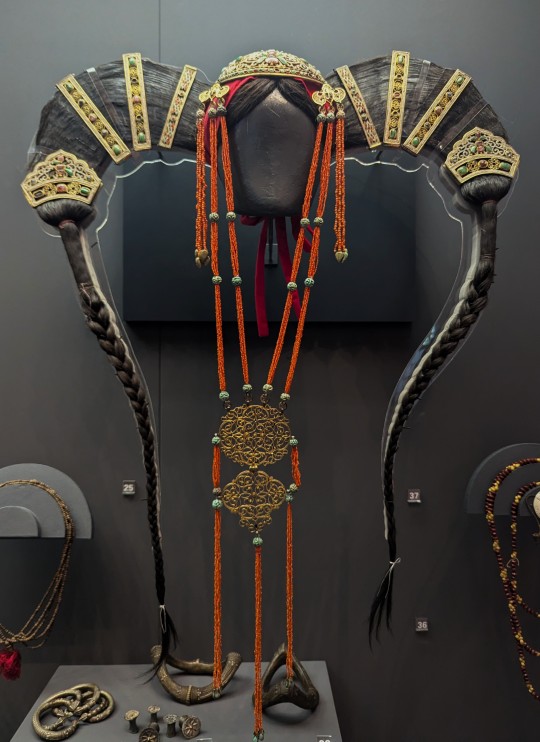
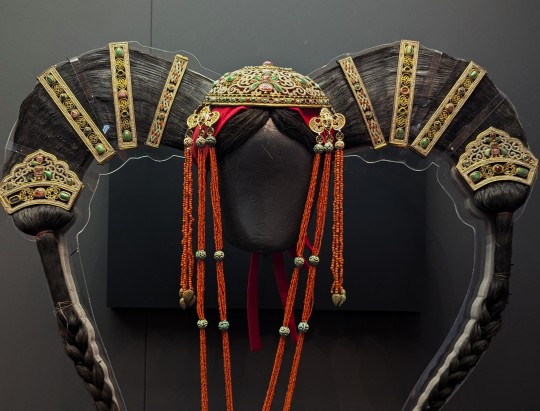
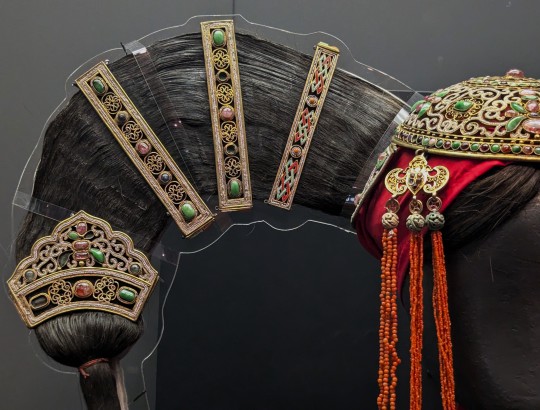
Khalkha Headdress from Outer Mongolia dated to the 19th Century on display at the McManuc Art Gallery and Museum in Dundee, Scotland
This headdress would have been commissioned from a silversmith for a Khalkha woman when she was to be married. It was presented to her on her wedding day and she was expected to wear it throughout her married life.
The Khalkha people were a diaspora group in Mongolia and in the early 20th century became one of the leading groups of the Mongolian Independence Movement. They campaigned for independence from the People's Republic of China. The Khalkha also found their lands taken by Imperial Russia and later the Soviet Union. Khalkha author Byambyn Rinchen translated and published Khalkha legal codes and folklore during the 1940's. He was a direct descendent of Genghis Khan through his mothers family.
Headpieces such as this from Mongolia were collected by European travellers and ambassadors and then donated to museums. Such fashion would go onto to inspire costume designers on Star Wars for Queen Amidala.
Photographs taken by myself 2024
#art#history#fashion#mongolia#mongolian#qing dynasty#19th century#mcmanus art gallery and museum#dundee#barbucomedie
121 notes
·
View notes
Note
Do you know if there's any initiation process for people to become sworn siblings?
Or do they just say, "You're my sworn sibling now." to each other?
I think it is comparable to the historical practice of "blood brothers" in which close companions would symbolically "mix blood" by pressing opened wounds against one another or drinking one another's blood. In some cultures with a more "eww. blood" attitude, a sacrifice was made in each other's honour to seal the deal instead.
In folklore; the only reason the gods in the Norse pantheon don't get rid of Loki despite their mischief, is because Loki and Odin are blood brothers.
Noted examples in East Asia mainly come from Mongolian and tribal Chinese accounts - in which it was common practice amongst dear friends and their children. One famous example is Temüjin aka Genghis Khan and his childhood friend Jamukha - the latter's betrayal and attempted usurping considered one of the Khan's greatest emotional losses.
For particularly Chinese sources I found this article about traditional Chinese Kinship, though most of the sources come from Taiwan.
The standard ritual was for each sworn sibling to add their names and dates to a contract and ritualistically burn it - as to add it to the infernal and celestial archives. "Can't return me without the receipt" - at it's finest.
Another familiar practice was for each sibling in the pact to add their blood to wine, and pass it around to drink.
It's a bit flexible depending on the individuals. Whether for personal or political reasons. But the "ideal" scenario is people who are so close, that they feel that they might as well by legally recognised as siblings. Sworn brethren could, for example, contribute to the dowry of a sworn sibling's daughter, preform mourning rituals for the others bio family, or becoming legal guardians of your sworn-sibling's kid in case of their death.
Or in the case of Confucian-era China outlawing homosexuality, it was a clever way to facilitate a same-sex marriage. Can't fault two guys for living together and raising their kids when it's a legally recognised practice! A bunch of friends could come together and make a brotherhood pact as a way to cheekily help others in the group be married in spirit when the state wouldn't recognise it.
Some folks even did it so that members in their bio family who were interested in eachother could have "a reason" to be interacting. Imperial gender norms be wildin' so hard that you can't talk to your crush without your dads being legally best bros.
This is why in chinese slang; "sworn brothers" is used as slang for "gay relationship". Aka "oh my god, they were roommates."-vine.
In JTTW: Sun Wukong and the Brotherhood/Seven Sages declare themselves sworn kin at the same time Wukong elects his Marshals and Generals. In this case, they are all close friends who officiate their sworn kinship through partying hard, and making sacrifices to both Heaven and Hell. They even have separate days out together.

(Source: Anthony C Yu translation)
Who knows, maybe a wedding was thrown in the mix? With all the drinking I wouldn't be shocked if there was some confusion with the ritual contract! XD
Wukong, re-reading the contract years later: "HA! Flood Dragon and Tamarin put themselves down as the other kind of sworn brother! Wonder if they even noticed that?" Bull King, there to check: "I doubt it. I'm just glad I'm not legally married to anyone. Don't want any loose ends before me and Iron Fan get hitched."
Erlang and the Six Lads of Plum Hill/Meishan Brothers are all sworn brothers too - in a more frat-boy/brothers-in-arms sense. They've all likely know each other for decades, and legit see each other equal to siblings. Notably, Erlang shares the bounty he received from capturing Sun Wukong fairly across his brothers (and presumably the remaining odd bit for the dog). Four of the brothers are Marshals while Two are Generals, giving more credence to the headcanon of Wukong's Stalwarts being his sworn family as well. In an odd bit of hilarity amongst the tense fight of Flower Fruit Mountain, the bros even rib Erlang for thinking too hard about Wukong.

Erlang, trying to be cool and edgy: "What a foul being to dare call himself equal to heaven. I ought to-" Plum Hill Lad: "Aww! Elder Bro has a crush!" Erlang, flustered: "I DO NOT!!" Plum Hill Lads, all cracking up and making kissy faces: "Then why are you thinking about him so much?" "Major sus bro!" "If you wanna fight him so much why don't you just marry him?" (*Invasion is paused as all six Plum Hill lads start rough-housing with their elder bro. Many head-noogies are inflicted.*) Wukong, on the ground: "You know what those guys are talking about Macaque?" Macaque, teasing: "Why, are you interested in him or something?" Wukong, blushing like a schoolgirl: "Oh my gawds! Stahp!"
Curiously, Wukong describes himself and Erlang as "sworn brothers" later in the book; suggesting that they had a close relationship at some point. One of my fave pieces of art (can't find it rn) is Erlang asking Wukong to be his "sworn brother", and Wukong assumes he means "spouse" and gets confused when Erlang mentions having six more. XD
A "lesser" case would be; The Tang Emperor declaring Xuanzang/Tripitaka his oath/sworn brother because the monk is doing him a solid. The Emperor shows his immense gratitude, and Tripitaka gains some political clout that he can throw around if he needs to (the Empress of the Kingdom of Women even sees this as a marriage bonus). Tripitaka def doesn't do the "blood" or sacrificial part of what these rituals imply, as per his Buddhist upbringing, but it's still seen as a binding oath. Rather, they bow to one another and declare their status are sworn bros before an image of the Buddha in the monastery.

In Tripitaka's case, it's more of Emperor Taizong being like; "Look, this pilgrimage is so important to me that I'm gonna legally and spirtually count you as my little brother so that you understand how much I trust you." Meanwhile the monk is like; "What?Thats a bit much don't you think?"
Later on, the promise of becoming one's sworn brother is passed between characters akin to "If you pull this off for me, I would straight up be your best bro."
And ofc the Pilgrims consider eachother sworn kin/brothers at the end of the story, even if they didn't do a ritual to seal it.
So yeah in summary:
Rituals can be performed but are not 100% required. Even a mutual declaration before an idol/holy image is enough. Whilst the Brotherhood of Sages celebrate their new pact through booze and partying and blood sacrifices - Tripitaka and the Tang Emperor just declared it while in a monastery.
People did it for money and political reasons too.
They also did it cus "It ain't gay if it's brotherhood."
Sworn kinship can be forged overtime.
The celestial and infernal archives have the reciepts.
Btw you can do a "sworn divorce" if you and your bro have a falling out.
Whilst the practice isn't really a thing in modern China, I imagine it's still common amongst yaoguai and/or celestials.
#jttw#jttw hcs#journey to the west#sun wukong#erlang shen#yang jian#liu er mihou#six eared macaque#demon bull king#tripitaka#tang sanzang#xuanzang#meishan brothers#lmk#lmk aus#lego monkie kid#dont know if I should put other jttw universes here but they still count
65 notes
·
View notes
Text
This 'red mirage' is scaring the shit out of me.
America, if you vote him in, you deserve every inch of what he's going to do to you.
Mass deportations, gutting government regulation and oversight; graft, corruption on a systemic level, abandoning our allies to Russia and China (Ukraine, Taiwan, sayonara!) or Netanyahu (good-bye Gaza, Lebanon, Syria), women dying in hospital parking lots or back alleys....just an overall disintegration of societal norms and the ties that bind.
I hope and pray I am wetting my pants unnecessarily and the 'blue wave' will arrive overnight and we wake up to Madame President-elect Harris. Else...another society will descend into the darkness that has swallowed every dynasty before. The British Empire, Roman Empire, Genghis Khan and the Mongol horde, the Persians, the Portuguese, the French...they all collapsed from within when the centre could not hold.
Gilead and darkness or Kamala and restoration. The choice could not have been clearer. Which path has America chosen?
51 notes
·
View notes